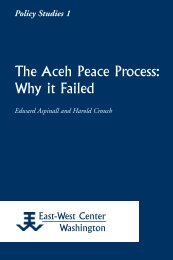Constructing Papuan Nationalism: History, Ethnicity ... - ScholarSpace
Constructing Papuan Nationalism: History, Ethnicity ... - ScholarSpace
Constructing Papuan Nationalism: History, Ethnicity ... - ScholarSpace
- No tags were found...
Create successful ePaper yourself
Turn your PDF publications into a flip-book with our unique Google optimized e-Paper software.
<strong>Constructing</strong> <strong>Papuan</strong> <strong>Nationalism</strong> 15control. During that period, the Dutch and <strong>Papuan</strong> flags were flowntogether as the flags of two independent nations, and the two nationalanthems were sung, alternating, as the flags were raised. According to thisdocument, the independent <strong>Papuan</strong> state had even issued its own currency,the New Guinea guilder (Alua 2002b: 28–29). Other statementsstopped short of asserting that Papua was already independent, while stillasserting that independence was being established. For example, whenreporting to President Abdurrahman Wahid on the 2000 <strong>Papuan</strong>Congress’s discussion about <strong>Papuan</strong> independence, Willy Mandowen, themoderator of the newly formed Presidium, asserted that in the early 1960sthere had been an “embryo” state of Papua (Alua 2002c: 123). Ironically,according to the Presidium’s interpretation, Indonesian President Sukarnohad himself affirmed the existence of the <strong>Papuan</strong> state. On December 19,1961, less than a month after the <strong>Papuan</strong>s had raised the Morning Star flagof independence, Sukarno delivered the Trikora speech, in which heordered the destruction of the Dutch-created puppet state of Papua. Thisspeech initiated a series of military actions that would annex Papua’s rightsof independence and sovereignty (Alua 2002c: 68, 79). In both theFORERI and the Presidium interpretations, the annexation was completedon May 1, 1963 (the day that Indonesia took over the administrationfrom the UN). It was arguments such as these that underlay Tom Beanal’sFebruary 1999 demand that Indonesia recognize and return Papua’s independence.14The argument that Papua was already independent drew on deepracial, cultural, geographic, and historical roots. The Presidium nationalistsof 2000 and after asserted that <strong>Papuan</strong>s were racially different from thepeoples of Maluku, the Lesser Sunda Islands, Sulawesi, and Java. <strong>Papuan</strong>shad black skin and curly hair just like the peoples of Papua New Guinea(PNG), the Solomon Islands, Vanuatu, and Fiji. Echoing Alfred RusselWallace, they also argued that the flora and fauna of Papua were differentfrom Indonesia’s (see Wallace 1962: 446–58). Viktor Kaisiepo, a memberof the Presidium and the son of one of the <strong>Papuan</strong> activists of the early1960s, pushed the argument further by asserting that even West Papua’snatural environment was seen by <strong>Papuan</strong>s as being inherently hostile toIndonesian rule. 15 Every animal, plant, and stone, he said, is a member ofthe OPM (Organisasi Papua Merdeka; the Free Papua Organisation). 16Geographically, Papua was part of the Pacific, rather than part of theIndonesian archipelago (Alua 2002a: 100).
















